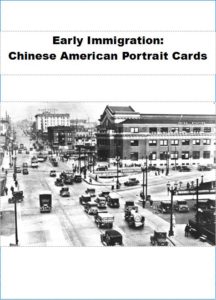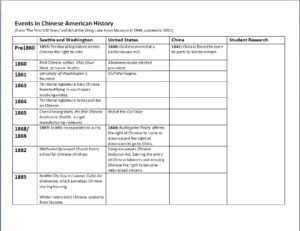Lesson 1
The Chinese American Immigrant Experience
Objective
Students will gain an overall understanding of the Chinese American immigrant experience through critical reading of portrait cards and demonstrate their learning through an interpretive writing exercise.
What You Will Need
Markers or chalk
Chart paper or chalk/white board
A world map (or a map which includes the United States and China)
Materials Provided in Curriculum
12 Portrait Cards
Book: Reflections of Seattle’s Chinese Americans: The First 100 Years
Student Timeline and Worksheet: Events in Chinese American History
Teacher Preparation
- Read pages 176 through 195 of Part II: “A History of Seattle’s Chinese Americans” by Doug Chin, which is in the book, “Reflections of Seattle’s Chinese Americans: The First 100 Years” by Ron Chew.
- Preview the Student Timeline Events in Chinese American History (to be used in Lesson Three).
- Read the portrait cards to prepare for the class activity. To obtain a more comprehensive view of the Chinese immigrant experience, read the fuller text for each individual found in the book, Reflections of Seattle’s Chinese Americans. (See Portrait Card text below, with the page number in the book where each portrait can be found.)
- Preview DVD Finding Home if it will be viewed (optional extension activity)
Activity I
- Write “Sojourner” on the chalk/white board. Ask and discuss with students what this word means.
- Discuss why the first Chinese immigrants came to America, while explaining “sojourner” in such context. Have students imagine and share what it would have been like when the Chinese immigrants first came, such as challenges and experiences they would encounter coming to a foreign land.
- On a world map, identify the provinces the first Chinese came from and the American states they left for.
Activity II
- Form student groups of 3 or 4; one is to be the reader and the rest to be the reporters. Then give out one or two Portrait Card(s) to each group.
- The reader will read the card to the group. Then have students discuss the following questions (for each of the cards) in their groups:
- Do you understand this person’s story? Any questions? Please discuss with your group members.
- What do you think of this person’s immigration experience?
- What contribution(s) do you think this person or his/her family brought to this country?
- Have the reporters share their answers to the questions above, and help contextualize the history by mentioning background information during students’ reports on the following main points: The unbalanced gender ratio, the types of jobs for Chinese laborers, immigration process, employment discrimination, and the significance of the Chinese family associations.
Assessment
Invite students to write about what they have learned of the Chinese American immigrant experience through an interpretive writing exercise.
Teacher’s note:
Interpretive writing is a piece in which the student’s purpose is to explain his or her own understanding of a given idea, topic, concept, problem, or situation. In this lesson, students should explain the experiences of the early Chinese settlers. The student’s explanation should be developed and supported with references to specific evidence from the portrait cards and information from class discussions.
Extension Activities
- Select some more oral histories from the Reflections book and share with the students to give them a more rounded view of the Chinese immigrant (and first generation born in the United States) experience.
- View the DVD Finding Home in Chinatown: The Kong Yick Buildings to learn more about the early Chinese American community in Seattle.
Finding Home in Chinatown: The Kong Yick Buildings is a 58-minute production on the history of Seattle’s Chinatown since the turn of the century. Told through footage of two historic buildings built in the heart of Chinatown in the early 1900s, the documentary also presents deeply personal remembrances of Chinatown offered by community elders and past residents who grew in Canton Alley before World War II. (Today, one of the Kong Yick Buildings is the home of the Wing Luke Museum.)
Teacher Information and Student Handouts on next pages:
- Teacher Version of Portrait Cards
- Events in Chinese American History (Timeline and Worksheet)


